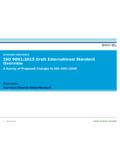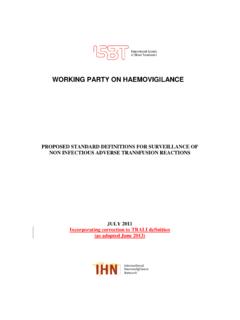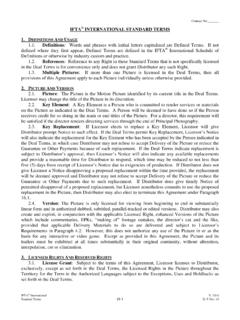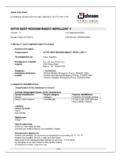Transcription of THE LIGHTNING PROTECTION INTERNATIONAL STANDARD
1 THE LIGHTNING PROTECTION INTERNATIONAL STANDARD Christian Bouquegneau, Chairman of IEC TC81 ( LIGHTNING PROTECTION ), Pro-rector of the Facult Polytechnique de Mons (Belgium) Abstract The Technical Committee on LIGHTNING PROTECTION of the INTERNATIONAL Electrotechnical Commission (IEC TC81) has finalised the new presentation of its work in four parts from general principles and risk management, to physical damage, life hazards and PROTECTION against electrical and electronic systems within structures. In this invited lecture we summarise their content and criticise the options chosen.
2 1. INTRODUCTION Following a world-wide scientific and technical work, IEC standards are based on scientifically proven theories and experimentation taking into account the INTERNATIONAL expertise in the matter. They lay down requirements for the design and installation of LPS ( LIGHTNING PROTECTION Systems) for structures and buildings, the PROTECTION against LIGHTNING of services entering the buildings and the PROTECTION of electrical and electronic systems. TC81 has achieved its first cycle of work when issuing a STANDARD (IEC 62305) in four parts (IEC 62305-1 to 4) listed below.
3 The complete STANDARD provides the general principles to be followed in the PROTECTION against LIGHTNING of structures (including their installations and contents as well as persons). Direct and nearby cloud-to-ground discharges can be hazardous to people, structures, their contents and installations, as well as to services. Hence the application of LIGHTNING PROTECTION measures must be considered. The need for PROTECTION , the economic benefits of installing PROTECTION measures and the selection of adequa- te PROTECTION measures should be determined in terms of Contact address: Pro-recteur Christian Bouquegneau, FPMs Rue de Houdain, 9, B-7000 Mons (Belgium) e-mail : risk management ; the risk management method is reported in IEC 62305-2.
4 The criteria for design, installation and maintenance of LIGHTNING PROTECTION measures are considered in separate groups: - PROTECTION measures to reduce physical damages and life hazards in a structure is reported in IEC 62305-3 ; - PROTECTION measures to reduce failure of electrical and electronic systems (inside) is reported in IEC 62305-4. In this STANDARD there is no limitation of height of the structures and buildings. Nevertheless, railway systems and vehicles, ships, aircraft and offshore installations are still outside its scope. The classification of the structures depends on the consequential effects of LIGHTNING flash which can cause damage to the structure, their contents or their surroundings.
5 2. LIST OF IEC TC81 standards The actual list of standards that is or will be issued by IEC TC81 is the following. IEC 62305-1 Part 1: PROTECTION of structures against LIGHTNING : general principles introduces terms and definitions, LIGHTNING current parameters, damages due to LIGHTNING , PROTECTION needs and measures, basic criteria for PROTECTION of structures and services as well as test parameters simulating the effects of LIGHTNING on LPS components; IEC 62305-2 Part 2 : Risk management introduces the risk assessment method, the assessment of risk components for structures and the assessment of risk components for services.
6 22 IEC 62305-3 Part 3 : Physical damage and life hazard is related to LIGHTNING PROTECTION systems (LPS), PROTECTION measures against injuries of living beings due to touch and step voltages and it offers a guideline for design, installation, maintenance and inspection of LPS ; IEC 62305-4 : Part 4 : Electrical and electronic systems within structures: it considers the PROTECTION against LIGHTNING Electromagnetic Pulses (LEMP): general principles; earthing and bonding inside structures; magnetic shielding and line routing, requirements of surge protective devices (SPD), PROTECTION of equipment in existing structures.
7 3. GENERAL PRINCIPLES Since it is impossible to avoid a LIGHTNING strike, the application of LIGHTNING PROTECTION measures must be considered. As was stated many times in the past, the conventional LIGHTNING PROTECTION philosophy, the methods and their practical implementation rest on a well found theoretical and empirical basis with a vast experience for the verification and validation of this method, mainly the so-called electro-geometric model (EGM or RSM : rolling sphere method considering a radius R equal to the striking distance or final jump distance). Other methods are proposed from time to time to the INTERNATIONAL commissions, without success so far.
8 For example, the CVM method (Collection Volume Method) recommended by the Australian Committee has received substantial criticism both concerning the method itself and the fact that it was neither accepted nor analysed by the INTERNATIONAL scientific community. Ambitions and potential earnings involved in the design of more effective LIGHTNING receptors is an obvious motivation for the invention and presentation of a lot of different LIGHTNING PROTECTION systems and items, where the claimed advantages have often been advertised, unfortunately without verification of their functions and validation of their effect.
9 So far parallel tests with simple Franklin rods and various ESE (Early Streamer Emission) devices exposed to natural LIGHTNING have shown no significant difference in the attraction distance nor in the number of strokes to the different types of rods. Hopefully in the future more effective LIGHTNING PROTECTION components and systems will be developed but until such systems are proven in a scientific sense their use should not be allowed for objects where PROTECTION is required. We have to remain reasonable and to be careful when issuing standards and guides. Of course IEC TC81 following confirmed scientists does not advertise such devices.
10 Direct cloud-to-ground discharges on or nearby a structure can damage it or strike persons as well as installations and their equipments. Parameters of LIGHTNING currents are selected from CIGRE (Conseil INTERNATIONAL des Grands R seaux Electriques Haute Tension) ; waveshapes result from various classifications : short and long duration components, leader polarity and direction,.. These parameters will be illustrated by several pictures at the oral presentation. Let us notice that the so-called M-components are not considered in the STANDARD . Four LIGHTNING PROTECTION levels LPL (I to IV, with 4 types of relevant PROTECTION measures for the design of LPS) are introduced; for each one, a set of maximum and minimum LIGHTNING current parameters is fixed: the maximum values of LIGHTNING current parameters relevant to LPL I will not be exceeded with a probability of 99 %; they are reduced to 75 % for LPL II and to 50 % for LPL III and IV.







